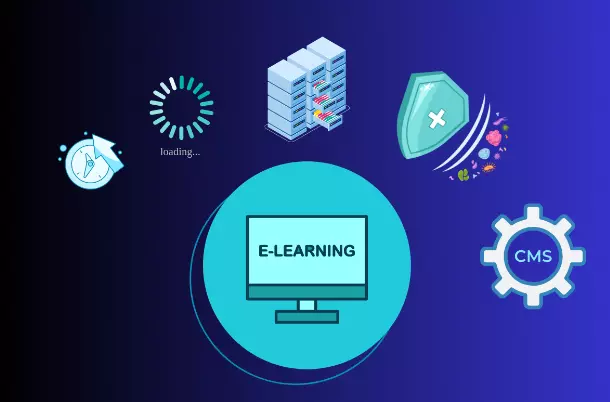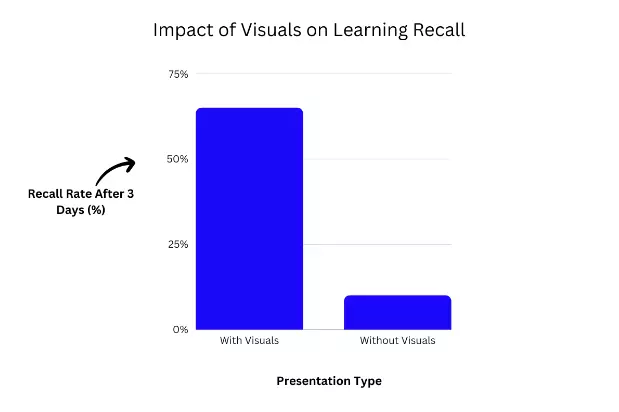
In this digital age, e-learning stands at the forefront of educational transformation, offering accessible, engaging, and interactive experiences. Central to this revolution is image hosting, going beyond storage to boost the learning experience.
This article presents five crucial image-hosting features that propel e-learning effectiveness and quality.
These features include reliable uptime and swift load times for seamless access, large file support for diverse and rich content, simple content management for efficient course handling, and robust security for optimal data protection.
These elements work harmoniously to transform e-learning, providing a high-quality, engaging, and secure educational environment.
Stay tuned as we explore how these must-have features contribute to an improved e-learning experience.
Why is Image Hosting Important in E-Learning?
Image hosting is a vital tool in e-learning, transforming simple lessons into interactive experiences. Let’s dive deeper into its significance.
How Image Hosting Benefits E-Learning
Image hosting offers several advantages in the e-learning landscape:
- Ease of Access: It enables easy accessibility of images for learners, regardless of their location.
- Efficient Storage: It provides a centralized space for storing and managing many images.
- Optimization: Image hosting platforms often provide tools to optimize images for faster load times and better user experience.
- Security: They offer robust security measures, protecting intellectual property and personal data against today’s cybersecurity threats.
The Role of Images in Learning and Cognition
Images are a powerful tool in learning, offering several cognitive benefits:
- Enhanced Retention: Visual information is easier to remember than text, improving knowledge retention.
- Increased Engagement: Images make content more engaging, capturing learners’ attention and interest.
- Aid Understanding: They can simplify complex concepts, aiding comprehension.
Facilitate Recall: Images can act as cues that help trigger the recall of information.
Image hosting is an invaluable tool in e-learning, revolutionizing how content is delivered and consumed.
It not only enhances the accessibility and security of visual resources but also facilitates an optimized, engaging learning experience. Coupled with the inherent cognitive benefits of images, it significantly boosts knowledge retention and understanding.
According to data from Changingminds.org, different presentation methods have varied impacts on learning recall. After three days, the recall rate for a spoken lecture drops to 10-20%, while for written material, it’s just 10%. However, visual and verbal presentations, like an illustrated lecture, retain a remarkable 65% recall rate. Check out the infographic below for a comparison of the two:

This highlights the significant role visuals and active engagement play in effective learning. Embracing these advantages will pave the way for a more prosperous, effective e-learning environment.
What are the 5 Must-Have Image Hosting Features to Boost E-Learning?
In the quest to maximize the effectiveness of e-learning, certain image hosting features stand out as crucial. Let’s delve into the five must-have features that can significantly enhance the e-learning experience.
1.Reliable Uptime
First on the frontline of must-have features to boost e-learning, reliable uptime.
Understanding Reliable Uptime
Within image hosting, uptime stands for the uninterrupted availability of hosted images. This term is a testament to an image hosting service’s reliability.
The uptime percentage measures this availability, with 100% uptime being the ideal — images are always accessible whenever required.
How Can Reliable Uptime Boost E-Learning?
- Enhanced User Experience: High uptime ensures uninterrupted access to images, making the learning process smoother and more efficient.
- Trust in the Learning Platform: Reliable uptime signifies a robust and dependable platform, which in turn instills confidence in learners about the consistency of the e-learning provider.
- Improved Learning Outcomes: With access to images when needed, students can effectively learn and recall information, leading to better learning outcomes.
Consequences of Unreliable Uptime
- Disrupted Learning Process: Unreliable uptime can cause unpredicted unavailability of images, leading to frequent disruptions and a fragmented learning process.
- Lower Learner Engagement: Interruptions in the learning process can cause confusion and frustration, leading to a decline in learner engagement and interest.
Damage to Reputation: Frequent downtime can harm the reputation of the e-learning provider, as it reflects poorly on their reliability and quality of service.
The significance of reliable uptime in image hosting for e-learning cannot be overstated. It acts as a pillar of a seamless learning experience, facilitating continuous access to crucial visual aids.
Conversely, unreliable uptime can create roadblocks in the learning journey, reducing engagement and trust. Therefore, to create a conducive and effective e-learning environment, ensuring reliable uptime is indispensable.
2.Quick Load Times
Moving forward, let’s explore the role of image hosting in offering rapid loading times and its subsequent impact in elevating the e-learning experience.
Understanding Quick Load Times in Image Hosting
‘’Quick Load Times’ in image hosting refers to the speed at which images stored on a hosting platform load and display on a user’s screen. This is influenced by factors like server speed, image size, and optimization techniques.
The faster the images load, the better the user experience, particularly in e-learning, where seamless access to visual content is crucial.
How Can Quick Load Times Boost E-Learning?
- Improved User Experience: Quick-loading images ensure a smooth, frictionless learning experience, preventing learners from experiencing delays or interruptions in their study flow.
- Increased Engagement: Rapid access to visual content keeps learners engaged and focused, reducing the chance of distractions or disinterest due to lagging load times.
Efficient Learning Process: Quick image loading speeds mean learners can proceed through content comfortably, promoting better comprehension and retention.
Consequences of Slow Loading Images in E-Learning
- Disrupted Learning: Slow-loading images can cause interruptions in the learning process, breaking the learner’s concentration and impacting their comprehension.
- Decreased Engagement: Lagging load times can lead to frustration and decreased learner engagement, which could result in learners abandoning the course or platform.
Negative Perception: Slow image loading can reflect poorly on the e-learning provider, damaging their reputation for delivering quality, efficient learning experiences.
In summary, quick load times in image hosting can dramatically impact the effectiveness of e-learning, making it a crucial feature for any e-learning platform. By ensuring rapid access to visual aids, e-learning providers can create a more engaging, efficient, and user-friendly learning environment.
Slow image loading times can interrupt the learning process, reduce learner engagement, and negatively impact the provider’s reputation.
3.Support for Large Files
Next, we’ll explore how image hosting’s capability to support large files can significantly enhance e-learning experiences.
Understanding Support for Large Files in Image Hosting
‘Support for large files’ in the context of image hosting refers to the capacity of the hosting service to store and manage large-sized image files. This ability is particularly important in e-learning, where high-quality images, diagrams, and infographics require substantial storage space.
How Can Support for Large Files Boost E-Learning?
- High-Quality Visuals: Large file support ensures high-resolution images can be used without compromising quality, offering learners clear and detailed visual aids for better understanding.
- Versatility in Content: It provides flexibility in the type and size of visual content that can be included in the learning material, enriching the overall learning experience.
Smooth User Experience: Effective management of large files ensures users can load and interact with high-quality images without performance issues, creating a seamless learning experience.
Consequences of Lack of Support for Large Files in E-Learning
- Compromised Image Quality: Without large file support, e-learning providers may need to use lower-quality images, potentially reducing the effectiveness of visual learning tools.
- Limited Content Options: The inability to host large files can restrict the diversity and quality of visual content included in e-learning courses.
Poor User Experience: If large files are not adequately supported, learners may face difficulties loading and interacting with the visual content, disrupting the learning process.
In a nutshell, support for large files in image hosting plays a pivotal role in e-learning.
It enables high-quality, detailed visuals that can enhance understanding and engagement. However, lacking this support can limit the quality and diversity of learning content and lead to a less satisfactory user experience.
For a well-rounded and enriching e-learning experience, image hosting with robust support for large files is essential.
4.Easy Content Management
Next on our list of must-have features, we focus on the convenience factor. Specifically, how easy content management can make a difference in the e-learning experience.
Understanding Easy Content Management in Image Hosting
‘Easy Content Management’ refers to the intuitive and efficient management of images hosted on a platform. This includes capabilities such as simple uploading, downloading, organizing, and modifying images, similar to what is often facilitated by Digital Asset Management (DAM) systems. This feature is crucial for e-learning providers who deal with many images as part of their course content.
How Can Easy Content Management Boost E-Learning?
- Efficiency: It simplifies managing many images, saving valuable time and resources for e-learning providers.
- Flexibility: Easy content management allows quick adjustments to course content, helping providers keep it up-to-date and relevant.
User-Friendly Interface: An intuitive content management system makes the learning platform more user-friendly, improving the learning experience.
Consequences of Poor Content Management in E-Learning
- Reduced Efficiency: Poor content management can make the handling of images cumbersome and time-consuming, reducing the overall efficiency of the learning process.
- Difficulty in Updating Content: Without easy content management, keeping course material current and relevant becomes challenging, potentially leading to outdated learning content.
Poor User Experience: A complex content management system can make the learning platform less intuitive and harder to navigate for learners, negatively impacting their learning experience.
In essence, easy content management is a critical feature of image hosting for e-learning. It streamlines the handling of visual content, enhances efficiency, and improves the user experience.
In contrast, poor content management can hamper the learning process, make content updates difficult, and lead to a less satisfactory user experience. Therefore, for a smooth and efficient e-learning experience, an image hosting platform with easy content management is indispensable.
5.Strong Security Measures
Rounding off our list of essential features, we address an aspect that is non-negotiable in today’s digital era—strong security measures. Let’s delve into why this feature is paramount in e-learning and image hosting.
Understanding Strong Security Measures in Image Hosting
Strong security measures in image hosting refer to the practices and tools used to protect hosted images from unauthorized access, alteration, or deletion. Given that e-learning platforms often handle sensitive data, including personal information, academic records, and copyrighted educational content, robust security measures are indispensable.
How Can Strong Security Measures Boost E-Learning?
- Data Protection: Robust security measures ensure sensitive data, such as student information or copyrighted images, are adequately protected, maintaining privacy and intellectual property rights.
- User Trust: Strong security measures foster a sense of safety and trust among users, which is critical for maintaining user engagement and satisfaction.
Compliance: Security measures help e-learning platforms comply with data protection regulations, avoiding potential legal issues.
Consequences of Weak Security Measures in E-Learning
- Data Breaches: Weak security measures can expose e-learning platforms to data breaches, resulting in loss of data and potential legal implications.
- Loss of Trust: If users feel their data isn’t safe, they may lose trust in the platform, leading to decreased usage or abandonment.
Non-Compliance: Without proper security measures, e-learning platforms may violate data protection laws, leading to penalties and damaging their reputation.
Strong security measures in image hosting are essential for e-learning. Not only do they protect sensitive data and ensure law compliance, but they also play a vital role in building user trust.
A recent survey found that 46% of consumers are willing to pay more for products and services from trusted brands. This means the more people recognize and believe in your brand, the more they’re likely to buy from you and even spend more. In e-learning, establishing trust can directly influence a platform’s profitability and success.
Conversely, weak security measures can lead to data breaches, loss of user trust, legal issues, and significant damage to the platform’s reputation. For a safe and trusted e-learning experience, robust security measures in image hosting are not just an option—they’re crucial.
Future of Image Hosting in E-Learning
The world of e-learning and image hosting is dynamic, with new developments and advancements on the horizon. So, what can we expect in the future?
Expected Advancements and Trends in Image Hosting for E-Learning
The future of image hosting in e-learning is filled with promising advancements. For example, we can expect enhancements in image processing and compression techniques that will allow faster load times and reduced storage requirements.
Artificial Intelligence, in particular, is poised to take center stage, with a key role to play in the enhancement of user experiences. AI will be more integrated into UX design, making interactions more personalized and interactive, a shift likely to impact image hosting and e-learning significantly.
Moreover, we could witness the rise of immersive image experiences through technologies like augmented reality (AR) and virtual reality (VR), adding an entirely new dimension to visual learning.
Potential Impact of These Advancements on the E-Learning Experience
These advancements could greatly enrich the e-learning experience. Faster load times and improved image quality could make learning more seamless and engaging.
AI-powered features could simplify content management, while AR and VR could provide more interactive and immersive learning experiences. Ultimately, these advancements in image hosting could pave the way for more effective, personalized, and immersive e-learning experiences.
Wrapping Up
As we’ve explored, image hosting is crucial in enhancing the e-learning experience, with features like reliable uptime, quick load times, support for large files, easy content management, and robust security measures integral to this process.
The transformative potential of these features and the expected advancements in this realm suggest that image hosting will continue to be a vital component of e-learning, pushing the boundaries of digital education.
As educators and learners navigate this dynamic landscape, staying in tune with these evolving technologies will be vital to maximizing the benefits of e-learning and shaping the future of education.
In essence, the interplay between image hosting and e-learning is an exciting arena of growth and innovation set to redefine the learning experiences of tomorrow.
Want to be at the forefront of this digital evolution? Harness the power of Cincopa’s advanced image hosting solution to elevate your e-learning modules. Try Cincopa’s image hosting for e-learning today and witness a transformative change in your digital education journey!








